Investment Decision Making at A&B Plc: A Comprehensive Business Report
VerifiedAdded on 2023/01/07
|10
|1409
|1
Report
AI Summary
This report examines the investment decision-making process of A&B Plc, a UK-based company. It analyzes two potential projects, a dishwashing project and a software project, using the payback period method and the net present value (NPV) method to assess their profitability. The payback period method calculates the time required to recover the initial investment, while the NPV method considers the time value of money. The report presents calculations for both projects, including cash inflows and total cash inflows. It also discusses financial factors like profitability, cost of investment, and interest rates, alongside non-financial factors such as demand, trends, and employee skills, influencing the investment decisions. The analysis concludes with a comparison of the two projects, highlighting the benefits of each investment option and considering financial and non-financial implications.

Business Decision Making
Table of Contents
Table of Contents
Paraphrase This Document
Need a fresh take? Get an instant paraphrase of this document with our AI Paraphraser

INTRODUCTION.................................................................................................................................3
MAIN BODY........................................................................................................................................3
Business decision making..................................................................................................................3
CONCLUSION.....................................................................................................................................7
REFERENCES......................................................................................................................................8
INTRODUCTION
Business decision making is all about analysing that company should invest in a
particular proposal of investment (Hafenstein and Bassen, 2016). This report is based on the
MAIN BODY........................................................................................................................................3
Business decision making..................................................................................................................3
CONCLUSION.....................................................................................................................................7
REFERENCES......................................................................................................................................8
INTRODUCTION
Business decision making is all about analysing that company should invest in a
particular proposal of investment (Hafenstein and Bassen, 2016). This report is based on the
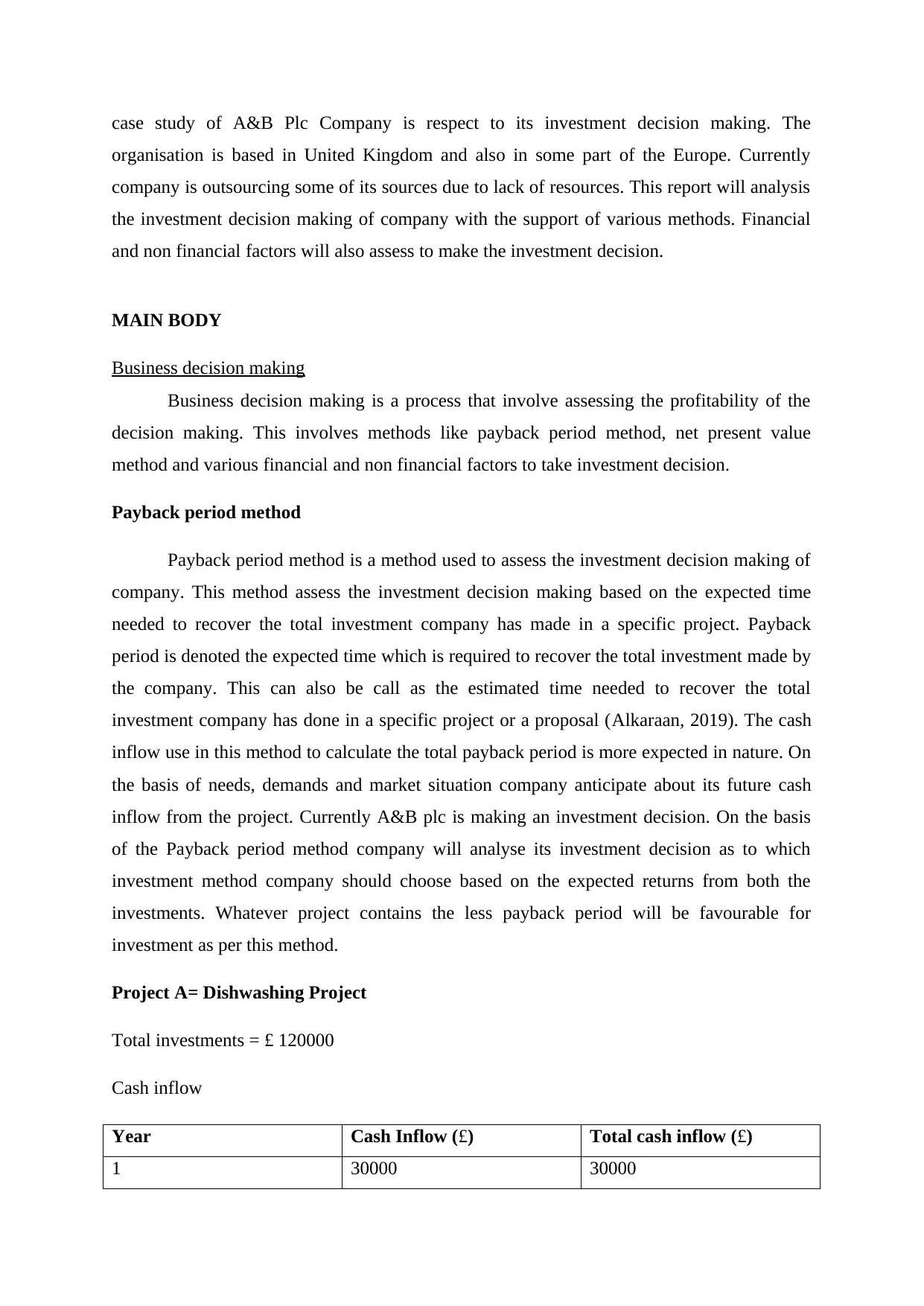
case study of A&B Plc Company is respect to its investment decision making. The
organisation is based in United Kingdom and also in some part of the Europe. Currently
company is outsourcing some of its sources due to lack of resources. This report will analysis
the investment decision making of company with the support of various methods. Financial
and non financial factors will also assess to make the investment decision.
MAIN BODY
Business decision making
Business decision making is a process that involve assessing the profitability of the
decision making. This involves methods like payback period method, net present value
method and various financial and non financial factors to take investment decision.
Payback period method
Payback period method is a method used to assess the investment decision making of
company. This method assess the investment decision making based on the expected time
needed to recover the total investment company has made in a specific project. Payback
period is denoted the expected time which is required to recover the total investment made by
the company. This can also be call as the estimated time needed to recover the total
investment company has done in a specific project or a proposal (Alkaraan, 2019). The cash
inflow use in this method to calculate the total payback period is more expected in nature. On
the basis of needs, demands and market situation company anticipate about its future cash
inflow from the project. Currently A&B plc is making an investment decision. On the basis
of the Payback period method company will analyse its investment decision as to which
investment method company should choose based on the expected returns from both the
investments. Whatever project contains the less payback period will be favourable for
investment as per this method.
Project A= Dishwashing Project
Total investments = £ 120000
Cash inflow
Year Cash Inflow (£) Total cash inflow (£)
1 30000 30000
organisation is based in United Kingdom and also in some part of the Europe. Currently
company is outsourcing some of its sources due to lack of resources. This report will analysis
the investment decision making of company with the support of various methods. Financial
and non financial factors will also assess to make the investment decision.
MAIN BODY
Business decision making
Business decision making is a process that involve assessing the profitability of the
decision making. This involves methods like payback period method, net present value
method and various financial and non financial factors to take investment decision.
Payback period method
Payback period method is a method used to assess the investment decision making of
company. This method assess the investment decision making based on the expected time
needed to recover the total investment company has made in a specific project. Payback
period is denoted the expected time which is required to recover the total investment made by
the company. This can also be call as the estimated time needed to recover the total
investment company has done in a specific project or a proposal (Alkaraan, 2019). The cash
inflow use in this method to calculate the total payback period is more expected in nature. On
the basis of needs, demands and market situation company anticipate about its future cash
inflow from the project. Currently A&B plc is making an investment decision. On the basis
of the Payback period method company will analyse its investment decision as to which
investment method company should choose based on the expected returns from both the
investments. Whatever project contains the less payback period will be favourable for
investment as per this method.
Project A= Dishwashing Project
Total investments = £ 120000
Cash inflow
Year Cash Inflow (£) Total cash inflow (£)
1 30000 30000
⊘ This is a preview!⊘
Do you want full access?
Subscribe today to unlock all pages.

Trusted by 1+ million students worldwide
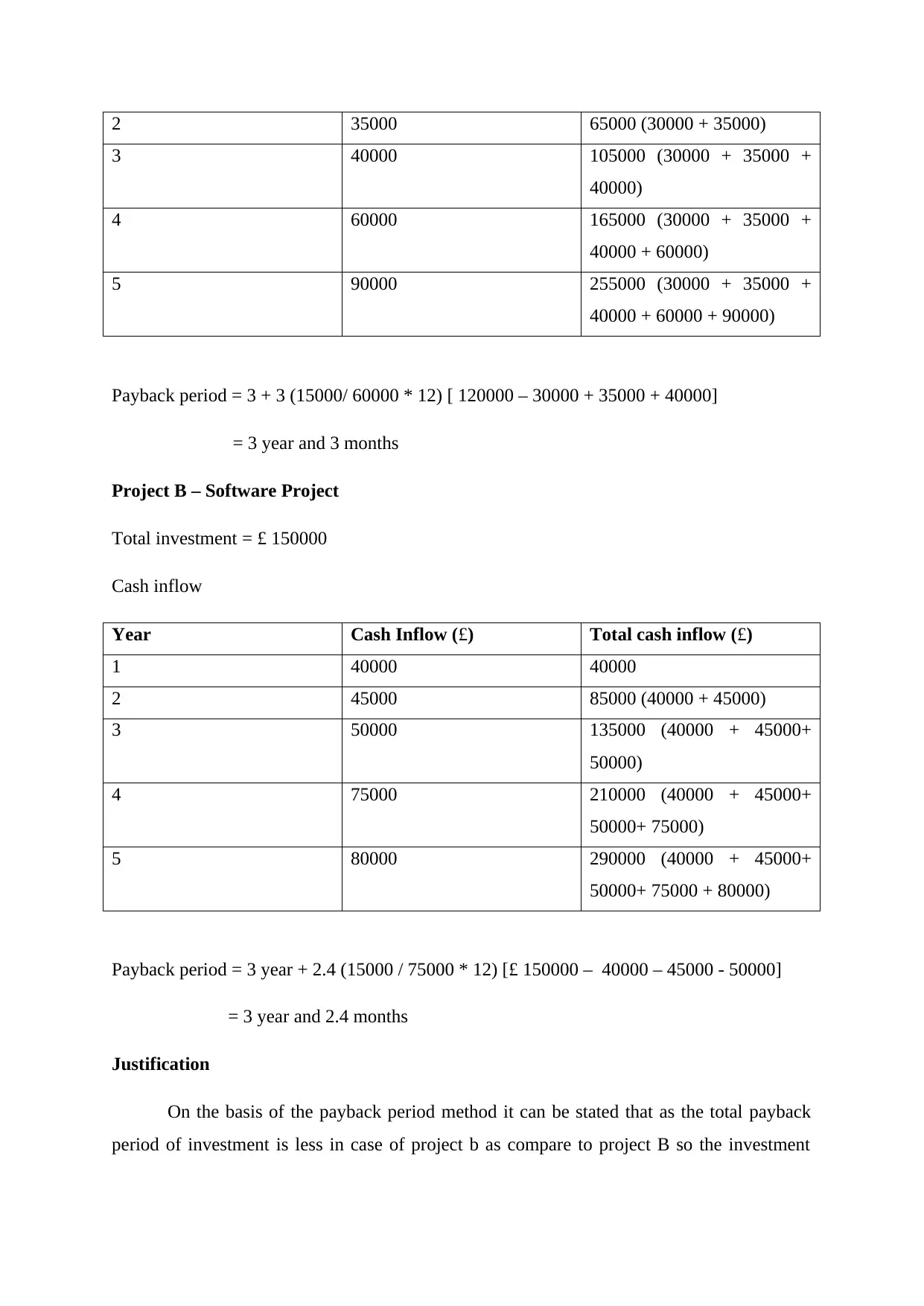
2 35000 65000 (30000 + 35000)
3 40000 105000 (30000 + 35000 +
40000)
4 60000 165000 (30000 + 35000 +
40000 + 60000)
5 90000 255000 (30000 + 35000 +
40000 + 60000 + 90000)
Payback period = 3 + 3 (15000/ 60000 * 12) [ 120000 – 30000 + 35000 + 40000]
= 3 year and 3 months
Project B – Software Project
Total investment = £ 150000
Cash inflow
Year Cash Inflow (£) Total cash inflow (£)
1 40000 40000
2 45000 85000 (40000 + 45000)
3 50000 135000 (40000 + 45000+
50000)
4 75000 210000 (40000 + 45000+
50000+ 75000)
5 80000 290000 (40000 + 45000+
50000+ 75000 + 80000)
Payback period = 3 year + 2.4 (15000 / 75000 * 12) [£ 150000 – 40000 – 45000 - 50000]
= 3 year and 2.4 months
Justification
On the basis of the payback period method it can be stated that as the total payback
period of investment is less in case of project b as compare to project B so the investment
3 40000 105000 (30000 + 35000 +
40000)
4 60000 165000 (30000 + 35000 +
40000 + 60000)
5 90000 255000 (30000 + 35000 +
40000 + 60000 + 90000)
Payback period = 3 + 3 (15000/ 60000 * 12) [ 120000 – 30000 + 35000 + 40000]
= 3 year and 3 months
Project B – Software Project
Total investment = £ 150000
Cash inflow
Year Cash Inflow (£) Total cash inflow (£)
1 40000 40000
2 45000 85000 (40000 + 45000)
3 50000 135000 (40000 + 45000+
50000)
4 75000 210000 (40000 + 45000+
50000+ 75000)
5 80000 290000 (40000 + 45000+
50000+ 75000 + 80000)
Payback period = 3 year + 2.4 (15000 / 75000 * 12) [£ 150000 – 40000 – 45000 - 50000]
= 3 year and 2.4 months
Justification
On the basis of the payback period method it can be stated that as the total payback
period of investment is less in case of project b as compare to project B so the investment
Paraphrase This Document
Need a fresh take? Get an instant paraphrase of this document with our AI Paraphraser
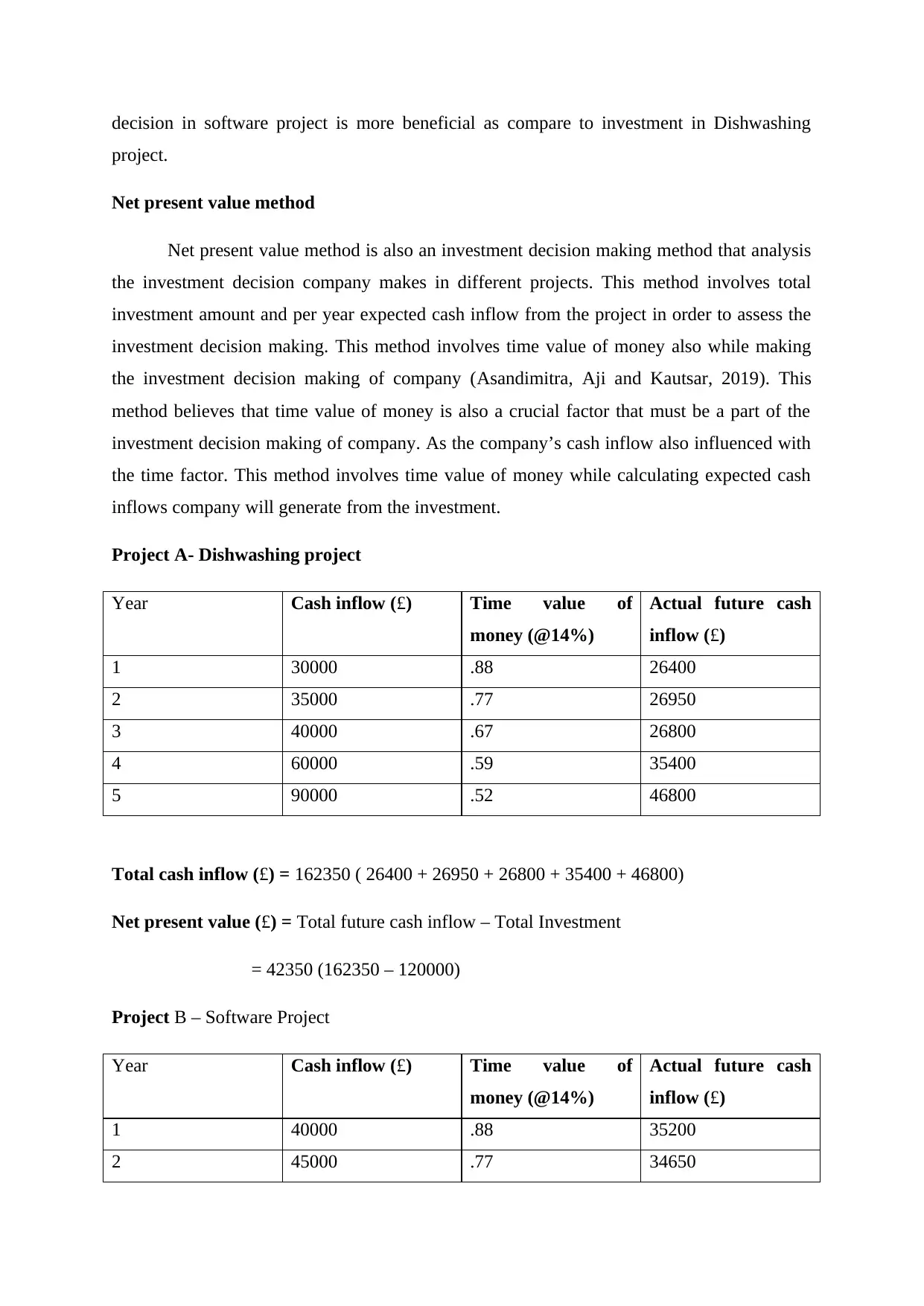
decision in software project is more beneficial as compare to investment in Dishwashing
project.
Net present value method
Net present value method is also an investment decision making method that analysis
the investment decision company makes in different projects. This method involves total
investment amount and per year expected cash inflow from the project in order to assess the
investment decision making. This method involves time value of money also while making
the investment decision making of company (Asandimitra, Aji and Kautsar, 2019). This
method believes that time value of money is also a crucial factor that must be a part of the
investment decision making of company. As the company’s cash inflow also influenced with
the time factor. This method involves time value of money while calculating expected cash
inflows company will generate from the investment.
Project A- Dishwashing project
Year Cash inflow (£) Time value of
money (@14%)
Actual future cash
inflow (£)
1 30000 .88 26400
2 35000 .77 26950
3 40000 .67 26800
4 60000 .59 35400
5 90000 .52 46800
Total cash inflow (£) = 162350 ( 26400 + 26950 + 26800 + 35400 + 46800)
Net present value (£) = Total future cash inflow – Total Investment
= 42350 (162350 – 120000)
Project B – Software Project
Year Cash inflow (£) Time value of
money (@14%)
Actual future cash
inflow (£)
1 40000 .88 35200
2 45000 .77 34650
project.
Net present value method
Net present value method is also an investment decision making method that analysis
the investment decision company makes in different projects. This method involves total
investment amount and per year expected cash inflow from the project in order to assess the
investment decision making. This method involves time value of money also while making
the investment decision making of company (Asandimitra, Aji and Kautsar, 2019). This
method believes that time value of money is also a crucial factor that must be a part of the
investment decision making of company. As the company’s cash inflow also influenced with
the time factor. This method involves time value of money while calculating expected cash
inflows company will generate from the investment.
Project A- Dishwashing project
Year Cash inflow (£) Time value of
money (@14%)
Actual future cash
inflow (£)
1 30000 .88 26400
2 35000 .77 26950
3 40000 .67 26800
4 60000 .59 35400
5 90000 .52 46800
Total cash inflow (£) = 162350 ( 26400 + 26950 + 26800 + 35400 + 46800)
Net present value (£) = Total future cash inflow – Total Investment
= 42350 (162350 – 120000)
Project B – Software Project
Year Cash inflow (£) Time value of
money (@14%)
Actual future cash
inflow (£)
1 40000 .88 35200
2 45000 .77 34650
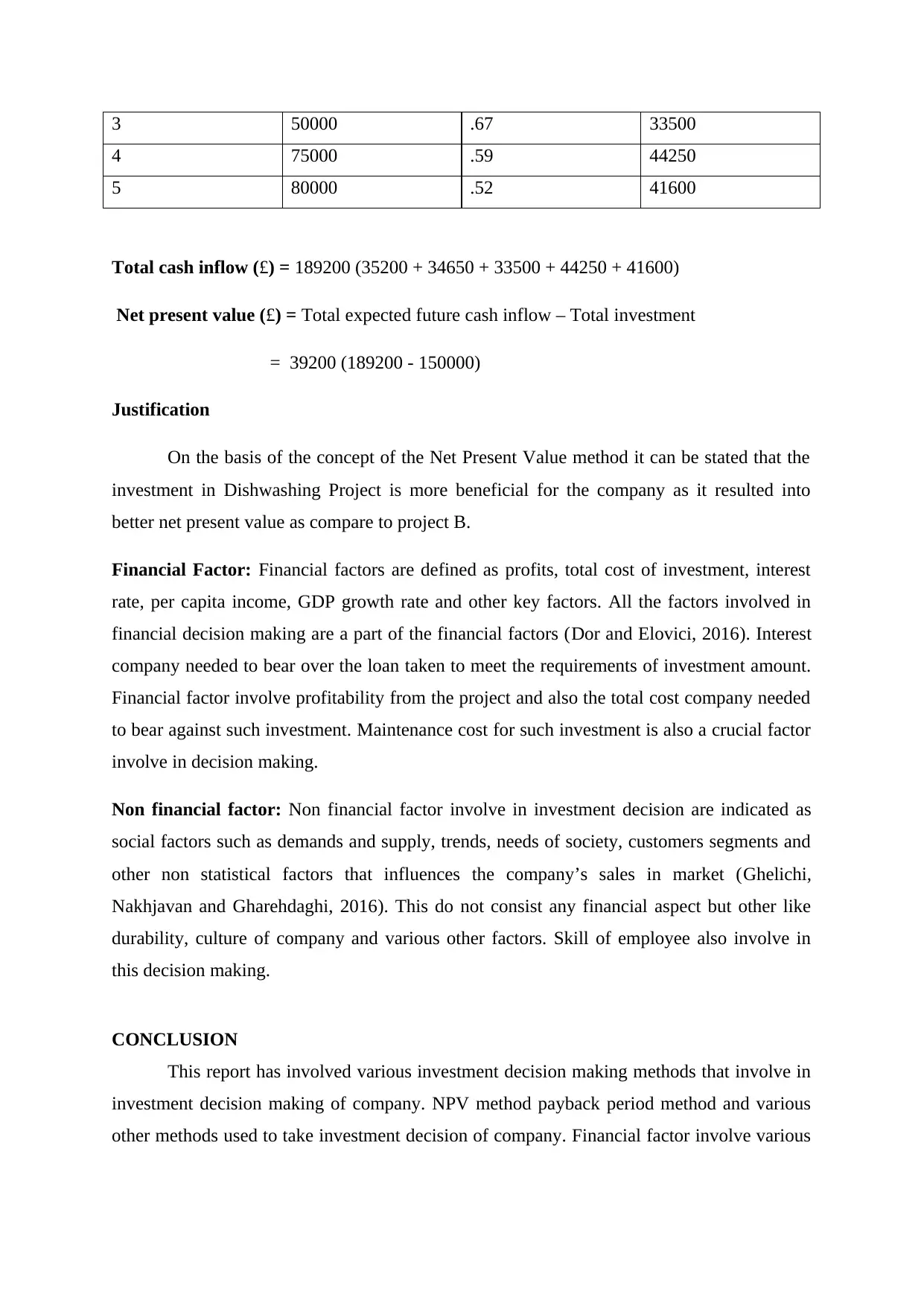
3 50000 .67 33500
4 75000 .59 44250
5 80000 .52 41600
Total cash inflow (£) = 189200 (35200 + 34650 + 33500 + 44250 + 41600)
Net present value (£) = Total expected future cash inflow – Total investment
= 39200 (189200 - 150000)
Justification
On the basis of the concept of the Net Present Value method it can be stated that the
investment in Dishwashing Project is more beneficial for the company as it resulted into
better net present value as compare to project B.
Financial Factor: Financial factors are defined as profits, total cost of investment, interest
rate, per capita income, GDP growth rate and other key factors. All the factors involved in
financial decision making are a part of the financial factors (Dor and Elovici, 2016). Interest
company needed to bear over the loan taken to meet the requirements of investment amount.
Financial factor involve profitability from the project and also the total cost company needed
to bear against such investment. Maintenance cost for such investment is also a crucial factor
involve in decision making.
Non financial factor: Non financial factor involve in investment decision are indicated as
social factors such as demands and supply, trends, needs of society, customers segments and
other non statistical factors that influences the company’s sales in market (Ghelichi,
Nakhjavan and Gharehdaghi, 2016). This do not consist any financial aspect but other like
durability, culture of company and various other factors. Skill of employee also involve in
this decision making.
CONCLUSION
This report has involved various investment decision making methods that involve in
investment decision making of company. NPV method payback period method and various
other methods used to take investment decision of company. Financial factor involve various
4 75000 .59 44250
5 80000 .52 41600
Total cash inflow (£) = 189200 (35200 + 34650 + 33500 + 44250 + 41600)
Net present value (£) = Total expected future cash inflow – Total investment
= 39200 (189200 - 150000)
Justification
On the basis of the concept of the Net Present Value method it can be stated that the
investment in Dishwashing Project is more beneficial for the company as it resulted into
better net present value as compare to project B.
Financial Factor: Financial factors are defined as profits, total cost of investment, interest
rate, per capita income, GDP growth rate and other key factors. All the factors involved in
financial decision making are a part of the financial factors (Dor and Elovici, 2016). Interest
company needed to bear over the loan taken to meet the requirements of investment amount.
Financial factor involve profitability from the project and also the total cost company needed
to bear against such investment. Maintenance cost for such investment is also a crucial factor
involve in decision making.
Non financial factor: Non financial factor involve in investment decision are indicated as
social factors such as demands and supply, trends, needs of society, customers segments and
other non statistical factors that influences the company’s sales in market (Ghelichi,
Nakhjavan and Gharehdaghi, 2016). This do not consist any financial aspect but other like
durability, culture of company and various other factors. Skill of employee also involve in
this decision making.
CONCLUSION
This report has involved various investment decision making methods that involve in
investment decision making of company. NPV method payback period method and various
other methods used to take investment decision of company. Financial factor involve various
⊘ This is a preview!⊘
Do you want full access?
Subscribe today to unlock all pages.

Trusted by 1+ million students worldwide

aspects like depreciation value of investment and various financial aspects. Non financial
factors cover all non financial terms to take investment decision.
REFERENCES
Books and Journals
factors cover all non financial terms to take investment decision.
REFERENCES
Books and Journals
Paraphrase This Document
Need a fresh take? Get an instant paraphrase of this document with our AI Paraphraser
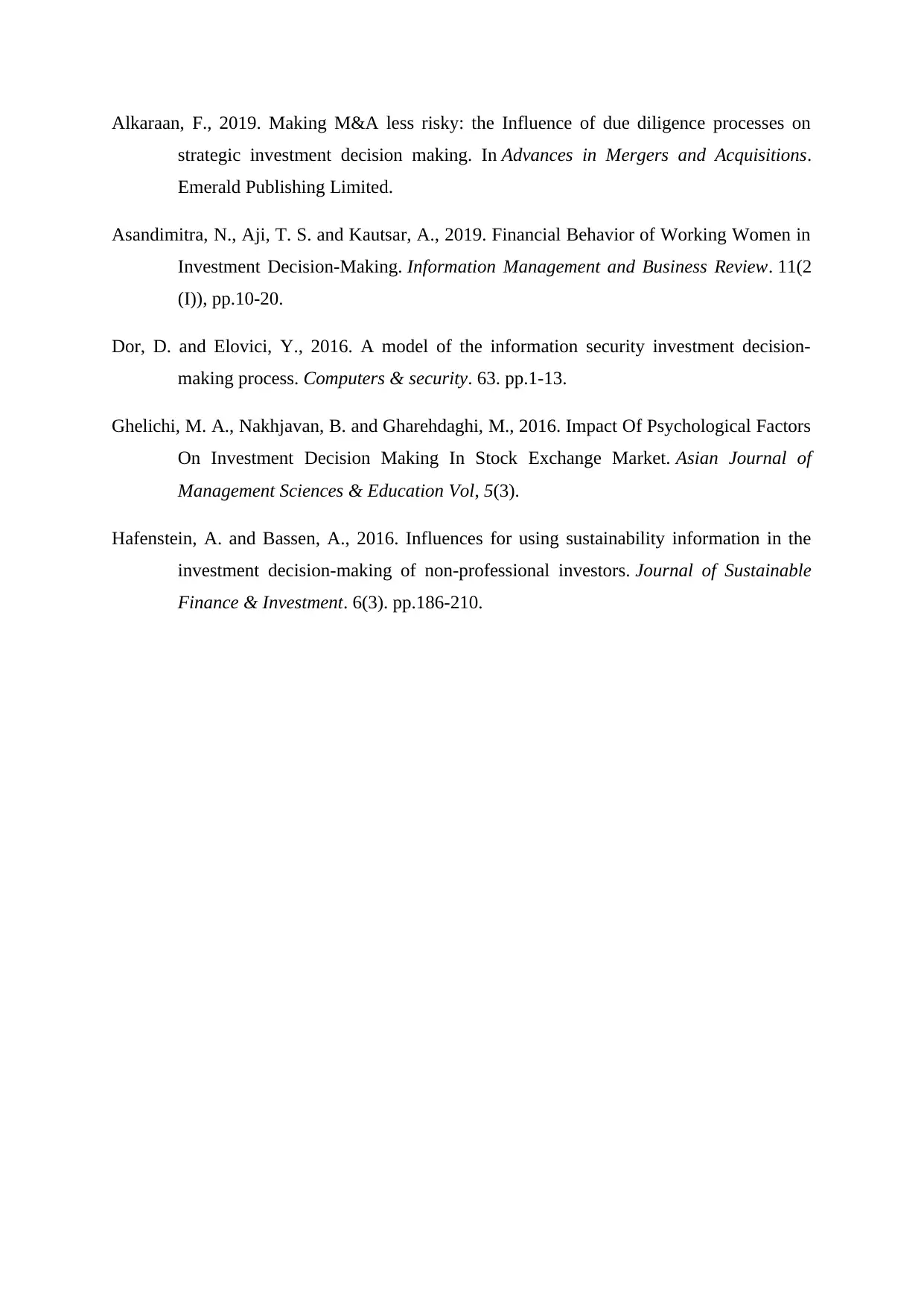
Alkaraan, F., 2019. Making M&A less risky: the Influence of due diligence processes on
strategic investment decision making. In Advances in Mergers and Acquisitions.
Emerald Publishing Limited.
Asandimitra, N., Aji, T. S. and Kautsar, A., 2019. Financial Behavior of Working Women in
Investment Decision-Making. Information Management and Business Review. 11(2
(I)), pp.10-20.
Dor, D. and Elovici, Y., 2016. A model of the information security investment decision-
making process. Computers & security. 63. pp.1-13.
Ghelichi, M. A., Nakhjavan, B. and Gharehdaghi, M., 2016. Impact Of Psychological Factors
On Investment Decision Making In Stock Exchange Market. Asian Journal of
Management Sciences & Education Vol, 5(3).
Hafenstein, A. and Bassen, A., 2016. Influences for using sustainability information in the
investment decision-making of non-professional investors. Journal of Sustainable
Finance & Investment. 6(3). pp.186-210.
strategic investment decision making. In Advances in Mergers and Acquisitions.
Emerald Publishing Limited.
Asandimitra, N., Aji, T. S. and Kautsar, A., 2019. Financial Behavior of Working Women in
Investment Decision-Making. Information Management and Business Review. 11(2
(I)), pp.10-20.
Dor, D. and Elovici, Y., 2016. A model of the information security investment decision-
making process. Computers & security. 63. pp.1-13.
Ghelichi, M. A., Nakhjavan, B. and Gharehdaghi, M., 2016. Impact Of Psychological Factors
On Investment Decision Making In Stock Exchange Market. Asian Journal of
Management Sciences & Education Vol, 5(3).
Hafenstein, A. and Bassen, A., 2016. Influences for using sustainability information in the
investment decision-making of non-professional investors. Journal of Sustainable
Finance & Investment. 6(3). pp.186-210.

⊘ This is a preview!⊘
Do you want full access?
Subscribe today to unlock all pages.

Trusted by 1+ million students worldwide

1 out of 10
Related Documents
Your All-in-One AI-Powered Toolkit for Academic Success.
+13062052269
info@desklib.com
Available 24*7 on WhatsApp / Email
![[object Object]](/_next/static/media/star-bottom.7253800d.svg)
Unlock your academic potential
Copyright © 2020–2025 A2Z Services. All Rights Reserved. Developed and managed by ZUCOL.





